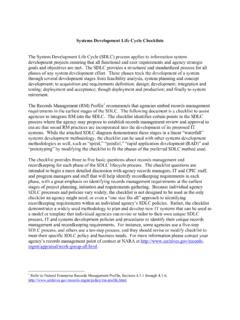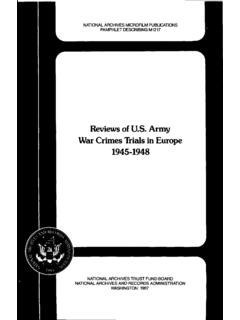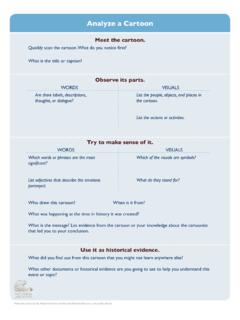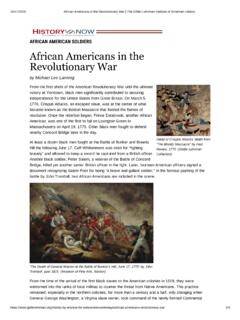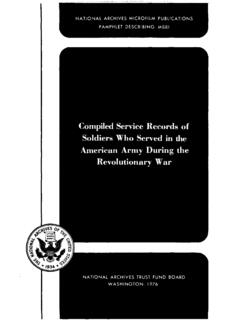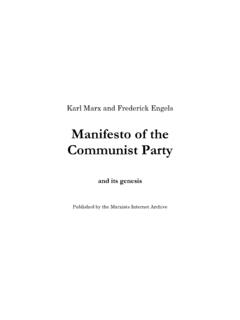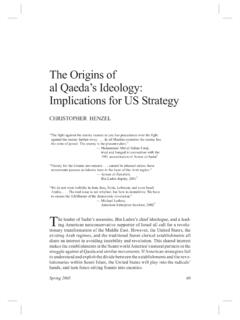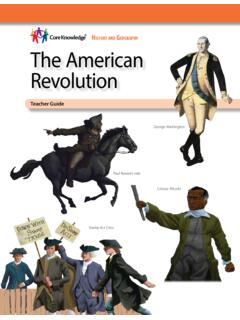Transcription of NATIONAL ARCHIVES MICROFILM PUBLICATIONS PAMPHLET ...
1 NATIONAL ARCHIVES MICROFILM PUBLICATIONSPAMPHLET DESCRIBING M804 NATIONAL ARCHIVES AND RECORDS SERVICEGENERAL SERVICES ADMINISTRATIONWASHINGTON: 1974 The records reproduced in the MICROFILM publicationare fromRecords of the Veterans AdministrationRecord Group 25 revolutionary WAR PENSIONAND BOUNTY-LAND-WARRANTAPPLICATION FILESOn the rolls of this MICROFILM publication are reproduced an estimated80,000 pension and bounty-land-warrant application files based on the partici-pation of American military, naval, and marine officers and enlisted men in theRevolutionary War. Most of the records in the files are dated between 1800 and1900.
2 The files are part of Record Group 15, Records of the and Bounty-Land-Warrant Legislationand Administration Relating toParticipation in the revolutionary WarPension LegislationFor more than a century before the beginning of the revolutionary War,British colonies in North America provided pensions for disabled soldiers andsailors. During and after the revolutionary War, three principal types of pensionswere provided by the Government for servicemen and their depend-ents. "Disability" or "invalid pensions" were awarded to servicemen for physicaldisabilities incurred in the line of duty; "service pensions," to veterans who servedfor specified periods of time; and "widows' pensions," to women whose husbandshad been killed in the war or were veterans who had served for specified periodsof August 26, 1776, the first pension legislation for the American coloniesas a group was enacted.
3 A resolution of the Continental Congress provided halfpay for officers and enlisted men, including those on warships and armed vessels,who were disabled in the service of the United States and who were incapable ofearning a living. The half pay was to continue for the duration of the May 15, 1778, another resolution provided half pay for 7 years afterthe conclusion of the war to all military officers who remained in the Continentalservice to the end of the war. Enlisted men who continued to serve for theduration of the conflict were each to receive a gratuity of $80 after the war underthe terms of the same enactment.
4 The first NATIONAL pension legislation forwidows was a Continental Congress resolution of August 24, 1780, which offeredthe prospect of half pay for 7 years to widows and orphans of officers who metthe requirements included in the terms of the resolution of May 15, 1778. OnOctober 21, 1780, the Continental Congress resolution of May 15, 1778, wasamended to provide half pay for life to officers after the war; but on March 22,1783, the half-pay-for-life provision was changed to 5 years' full legislation during the revolutionary War was designed toencourage enlistment and acceptance of commissions and to prevent desertionand resignation.
5 After iKe \var, pensions became a form of reward for servicesrendered. Both during jtter the Revolution, the States as well as the awarded pensio1' based on participation in the conflict. The recordsreproduced in this MICROFILM publication pertain only to pensions granted or paidpursuant to public and priv n<- acts of the Government. Public acts, underlwhich the majority of such pensions were authorized, encompassed large classesof veterans or their dependents who met common eligibility requirements. Pri-vate acts concerned specific individuals whose special services or circumstancesmerited consideration, but who could not be awarded pensions under existingpublic September 29, 1789 (1 Stat.)
6 95), the First Congress of the UnitedStates passed an act which provided that invalid pensions previously paid by theStates, pursuant to resolutions of the Continental Congress, should be continuedand paid for 1 year by the newly established Federal Government. Subsequentlegislation often extended the time limit. An act of Congress approved March 23,1792 (1 Stat. 243), permitted veterans not already receiving invalid pensionsunder resolutions of the Continental Congress to apply for them directly to theFederal Government. On April 10, 1806 (2 Stat. 376), the scope of earlierinvalid-pension laws pertaining to revolutionary War servicemen was extended tomake veterans of State troops and militia service eligible for Federal pen-sions.
7 The act superseded all previous revolutionary War invalid-pension 1818 NATIONAL pension laws concerning veterans of the Revolution(with the exception of the Continental Congress resolution of May 15, 1778,granting half pay to officers for service alone) specified disability or death of aserviceman as the basis for a pension award. Not until March 18, 1818 (3 ), did the Congress grant pensions to revolutionary War veterans forservice from which no disabilities resulted. Officers and enlisted men in need ofassistance were eligible under the terms of the 1818 act if they had served in aContinental military organization or in the naval service (including theMarines) for 9 months or until the end of the war.
8 Pensions granted under thisact were to continue for service-pension act of 1818 resulted in a great number of applications,many of which were approved. Congress had to appropriate greater sums thanever before for revolutionary War pension payments. Financial difficulties andcharges that applicants were feigning poverty to obtain benefits under the termsof the act caused Congress to enact remedial legislation on May 1, 1820 (3 ). The new law required every pensioner receiving payments under the 1818act, and every would-be pensioner, to submit a certified schedule of his estate andincome to the Secretary of War.
9 The Secretary was authorized to remove fromthe pension list the names of those persons who, in his opinion, were not in needof assistance. Within a few years the total of revolutionary War servicepensioners was reduced by several thousand. An act of Congress approved March 1,1823 (3 Stat. 782), resulted in the restoration of pensions to many whosenames had been removed under the terms of the 1820 legislation, but whosubsequently proved their need for passed another service-pension act on May 15. 1828 (4 ), which granted full pay for life to surviving officers and enlisted men of theRevolutionary War who were eligible for benefits under the terms of theContinental Congress resolution of May 15, 1778, as last and most liberal of the service-pension acts benefiting Revolu- tionary War veterans was passed on June 7, 1832 (4 Stat.)
10 529), and extended tomore persons the provisions of the law of May 15, 1828. The act provided thatevery officer or enlisted man who had served at least 2 years in the ContinentalLine or State troops, volunteers or militia, was eligible for a pension of full payfor life. Naval and marine officers and enlisted men were also included. Veteranswho had served less than 2 years, but not less than 6 months, were eligible forpensions of less than full pay. Neither the act of 1832 nor the one of 1828required applicants to demonstrate need. Under the act of 1832 money due fromthe last payment until the date of death of a pensioner could be collected by hiswidow or by his time limit for making claims under the Continental Congressresolution of August 24, 1780, which promised half-pay pensions to widows andorphans of some officers, expired in -1794.


